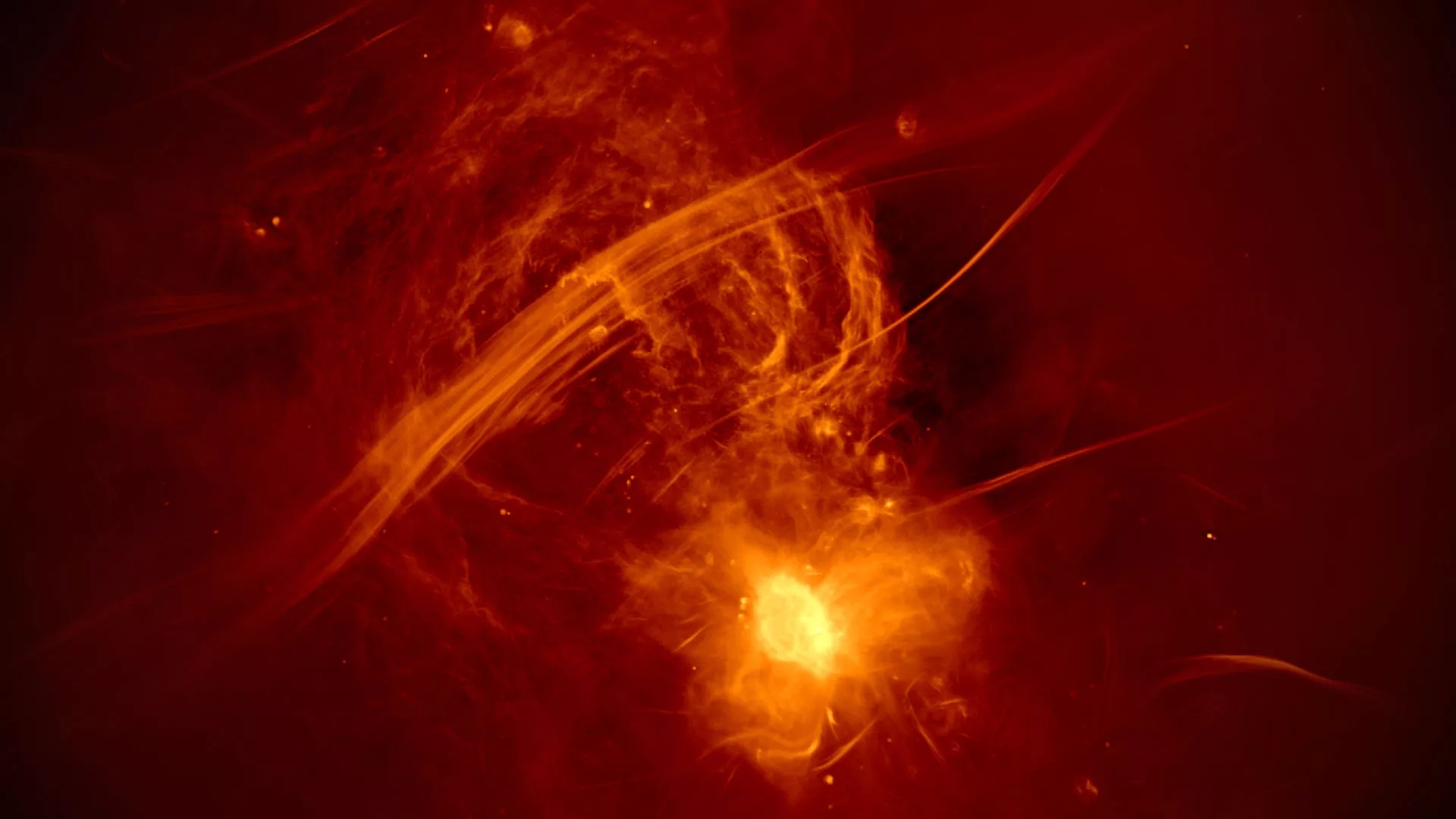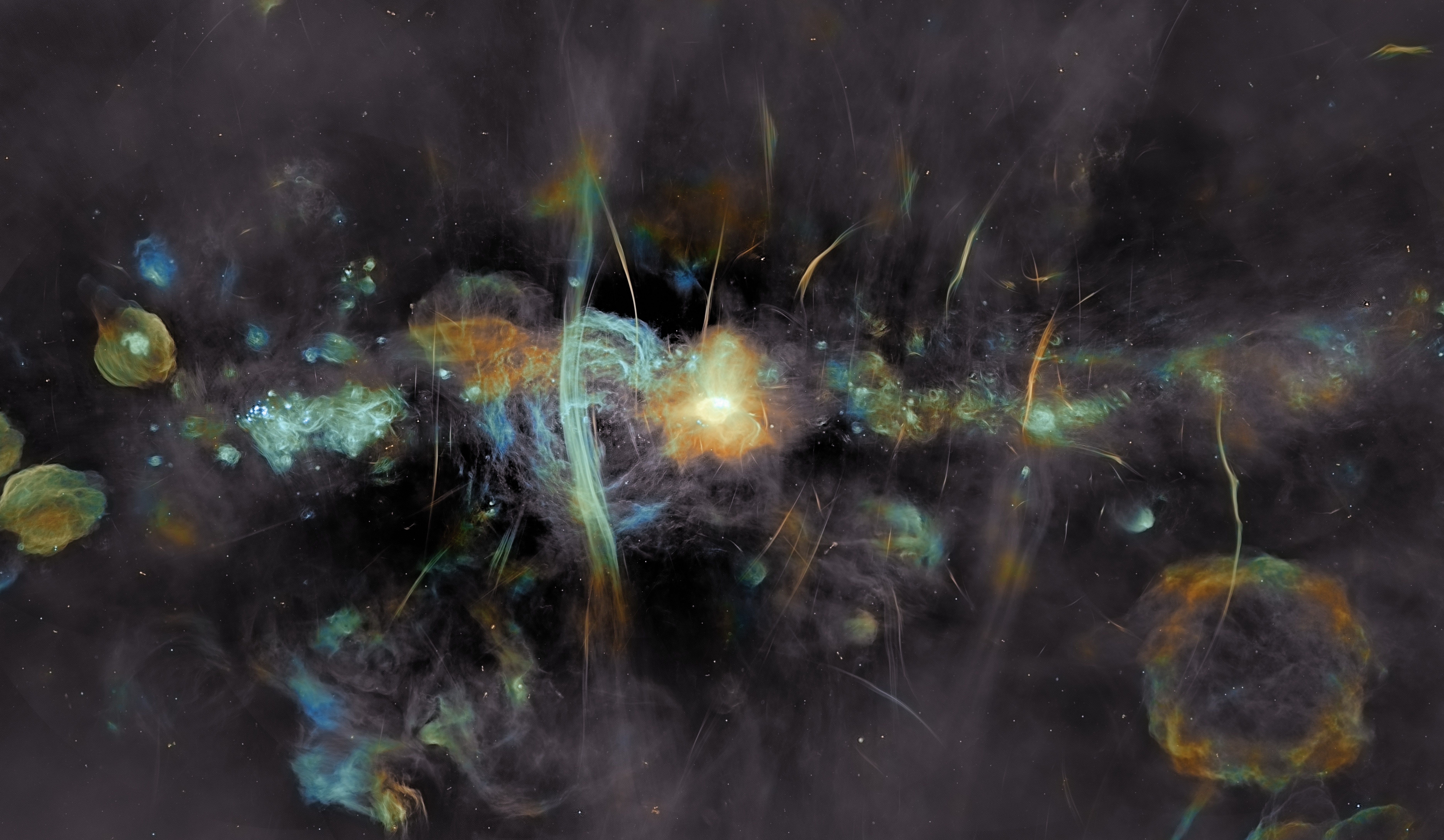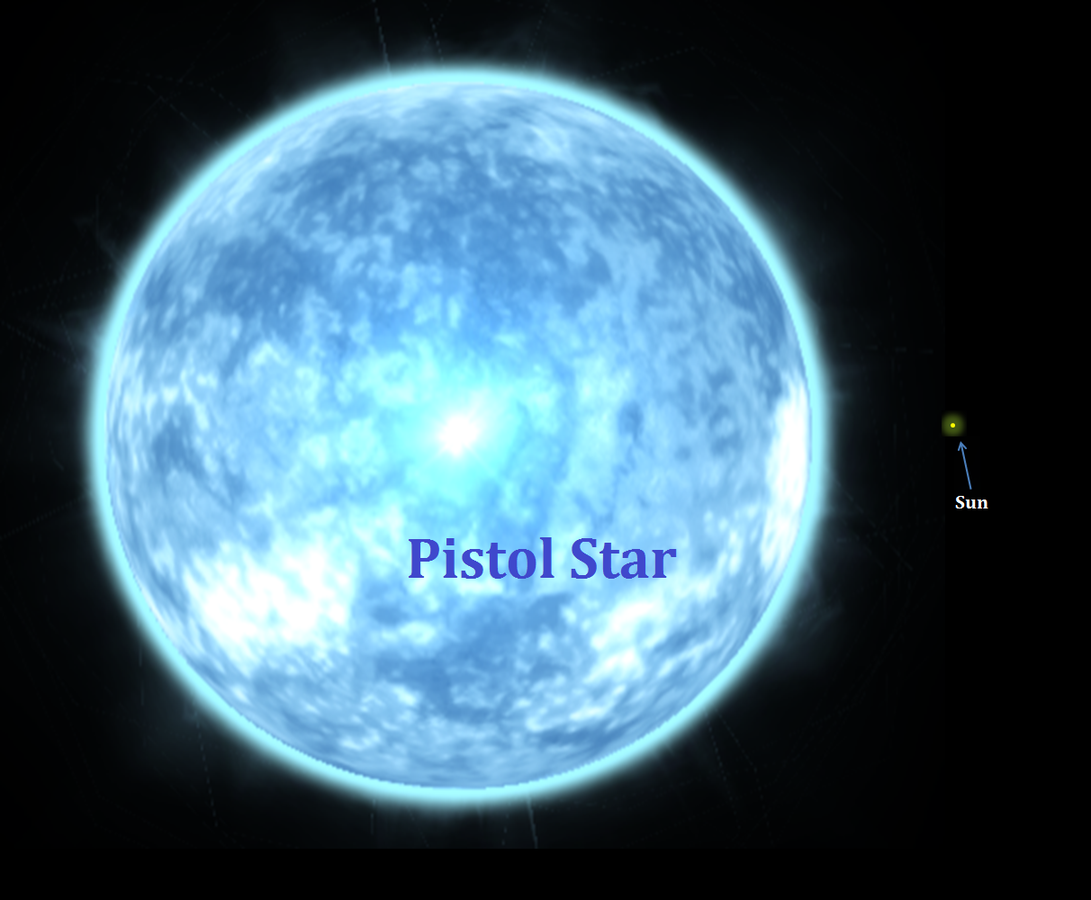


If you could see X-rays, maybe you'd see this.
Near the Galactic Center, the Fermi bubbles would glow bright: I talked about those in my February 1st diary entry. But there's a lot more going on, too! For example the supernova remnant Vela, the neutron star Scorpius X-1 and a lot of activity in the constellation of Cygnus would stand out.
Scorpius X-1 was the first X-ray source in space to be found after the Sun. It was discovered by accident when a rocket launched to detect X-rays from the Moon went off course!
But why is it making so many X-rays?
Scorpius X-1 is a double star about 9,000 light-years away from us. It's a blue-hot star orbiting a neutron star that's three times as heavy. As gas gets stripped off from the lighter star and sucked into the neutron star, it first forms a spinning disk. As it spirals down into the neutron star, it releases a tremendous amount of energy.
This gas is near the 'Eddington limit’, where the pressure of radiation pushing outward and the gravitational force pulling inward are in balance!
Scorpius X-1 puts out about 23000000000000000000000000000000 watts of power in X-rays! Yes, that's \(2.3 \times 10^{31}\) watts. This is 60,000 times the X-ray power of our Sun.
Scorpius X-1 is considered a low-mass X-ray binary: the neutron star is roughly 1.4 solar masses, while the lighter star is only 0.42 solar masses. These stars were probably not born together: the binary may have been formed by a close encounter inside a globular cluster.
The lighter star orbits about once every 19 days.
Puzzle. Why is such a light star blue-hot, rather than a red dwarf?
I want to read more about Scorpius X-1 and similar X-ray binaries! Besides the Wikipedia article:
I'm finding technical papers like this:
which gets into details like "The insertion of the calcite slab in the light path results in the projection of two target beams on the detector." But I'd like to read a synthesis of what we know, like an advanced textbook.
By the way, Scorpius X-1 is the answer to the puzzle in my
February 2 diary entry.
March 3, 2023
If you could see in X-rays, one of the brightest things you'd see in the night sky is the Vela pulsar. It was formed when a huge star's core collapsed about 12,000 years ago.
The outer parts of the star shot off into space. Its core collapsed into a neutron star about twice the mass of our Sun — but just 20 kilometers in diameter! Today it's spinning around 11.195 times every second. As it whips around, it spews out jets of charged particles moving at about 70% of the speed of light. These make X-rays and gamma rays.
The Chandra X-ray telescope made a closeup video of the Vela pulsar! It shows this jet is twisting around.
But the most interesting part of all this, to me, are the 'glitches' when the neutron star suddenly spins a bit faster. Let me tell you a bit about those.
First, I can't resist showing you what happened to the star that exploded. It made this: the Vela Supernova Remnant. It's so beautiful!
This photo was taken, not by a satellite in space, but by Harel Boren in the Kalahari Desert in Namibia!
Then, I can't resist showing you a little movie of the Vela pulsar... slowed down:
This was made using the Fermi Gamma-Ray Space Telescope. The image frame is large: 30 degrees across. The background, which shows diffuse gamma-ray emission from the Milky Way, is shown about 15 times brighter than it actually is.
Then I can't resist showing you a closeup photo of the Vela pulsar, taken in X-rays by the Chandra X-ray Observatory:
The bright dot in the middle is the neutron star itself, and you can see one of the jets poking out to the upper right, while the other is aimed toward us.
Now, about those glitches.
Since it's putting out powerful jets, which carry angular momentum, we expect the Vela pulsar to slow down — and it does. But it does so in a funny way: every so often there's a glitch where it speeds up for about 30 seconds! Then it returns to its speed before the glitch — gradually, in about 10 to 100 days.
What's going on? A neutron star has 3 parts: the outer crust, inner crust, and core. The outer crust is a crystalline solid made of atoms squashed down to a ridiculous density: about 10¹¹ grams per cubic centimeter. But the inner crust contains neutron-rich nuclei floating in a superfluid made of neutrons!
Yes: while helium becomes superfluid and loses all viscosity due to quantum effects only when it's really cold, highly compressed neutrons can be superfluid even at very high temperatures And the funny thing about a superfluid is that the curl of its flow is zero except along vortices which carry quantized angular momentum, coming in chunks of size \(\hbar\).
Glitches must be caused by how the outer crust interacts with the inner crust. The outer crust slows down. The inner crust, being superfluid, does not. This can't go on forever, since they rub against each other. So it seems that now and then a kind of crisis occurs: in a chain reaction, vast numbers of superfluid vortices suddenly transfer some angular momentum to the outer crust, speeding it up while reducing their angular momentum. It's analogous to an avalanche.
So, we are seeing complicated quantum effects in a huge spinning star 1000 light years away!
You've probably heard there's a supermassive black hole at the center of the Milky Way — and also that near the center of our galaxy there are a lot more stars. But did you ever think hard about what the Galactic Center is like?
I didn't, until recently. As a kid I read about it in science fiction — like Asimov's Foundation trilogy, where the capital of the Empire is near the Galactic Center on the world of Trantor, with a population of 40 billion. That shaped my impressions.
But now we know more. And it turns out the center of our galaxy is a wild and woolly place! Besides that black hole 4 million times the mass of our Sun, it's full of young clusters of stars, supernova remnants, molecular clouds, weird filaments of gas, and more.
It's in the constellation of Sagittarius, abbreviated 'Sgr'. Let me go through the various features named above and explain them.
Sgr A contains the supermassive black hole called Sgr A*, which is worth a whole article of its own. Surrounding that is the Minispiral: a three-armed spiral of dust and gas falling into the black hole at speeds up to 1000 kilometers per second.
Also in Sgr A, surrounding the Minispiral, there is a torus of cooler molecular gas called the 'Circumnuclear Disk’:
The inner radius of the Circumnuclear Disk is almost 5 light years. And inside this disk there are over 10 million stars. That's a lot! Remember, the nearest stars to our Sun are 4 light years away.
Even weirder, among these stars there are lots of old red giants — but also many big, young stars that formed in a single event a few million years ago. These include about 100 OB stars, which are blue-hot, and Wolf-Rayet stars, which have blown off their outer atmosphere and are shining mainly in the ultraviolet.
Nobody knows how so many stars were able to form inside the Circumnuclear Disk espite the gravitational disruption of central black hole, and why so many are young. This is called the 'paradox of youth'.
Stars don't seem to be forming now in this region. But some predict that stars will form in the Circumnuclear Disk, perhaps causing a starburst in 200 million years, with many stars forming rapidly, and supernovae going off at a hundred times the current rate! As gas from these falls into the central black hole, life may get very exciting.
As if this weren't enough, a region of Sgr A called Sgr A East contains a structure is approximately 25 light-years in width that looks like a supernova remnant, perhaps created between 35 and 100 thousand years ago. However, it would take 50 to 100 times more energy than a standard supernova explosion to create a structure of this size and energy. So, it's a bit mysterious.
Moving further out, let's turn to the Radio Arc, called simply 'Arc' in picture at the top of this diary entry. This is the largest of a thousand mysterious a filaments that emit radio waves. It's obvious that the Galactic Center is wild, but these make it 'woolly'. Nobody knows what causes them!
Here is the Radio Arc and some filaments:

Behind the Radio Arc is the Quintuplet Cluster, which contains one of the largest stars in the Galaxy — but more about that some other day.
Sgr B1 is a cloud of ionized gas. Nobody knows why it's ionized. Like the filaments, perhaps it was heated up back when the black hole was eating more stars and emitting more radiation. Sgr B1 is connected to Sgr B2, a giant molecular cloud made of gas and dust, 3 million times the mass of the Sun.
The distance from Sgr A to Sgr B2 is 390 light years. That gives you a sense of the scale here! The whole picture spans a region in the sky 4 times the angular size of the Moon.
The two things called SNR are supernova remnants — hot gas shooting outwards from exploded stars. For example, in the top picture at lower right we see SNR 359.1-0.5, which looks like this close up:
The filament at right is called the Snake, while the Mouse at left is actually supposed to be a runaway pulsar. It looks like the Mouse is running away from the Snake! But that's probably a coincidence.
Sgr D is another giant molecular cloud, and Sgr C is a group of molecular clouds.
So, a lot is going on in our galaxy's center! Out here in the boondocks it's more quiet.
Let me show you the first picture in all its glory without the labels. Click to enlarge:

It's almost impossible to see the Galactic Center in visible light through all the dust, so this is an image in radio waves, made by the MeerKAT array of 64 radio dishes in South Africa. It was made by Ian Heywood with color processing by Juan Carlos Munoz-Mateos.
Here are two other versions of the same image, processed in different ways. Click to enlarge!

I got an email from Neil Sloane, who runs the famous Online Encyclopedia of Integer Sequences, saying that he created an entry for the sequence I touched upon in my February 8th diary entry, and these blog articles:
(I don't think we have ever met, but your name appears in many OEIS entries. I guess John Conway was a mutual friend.)I replied, saying among other things:
It'd be exaggerating to say that Conway was my friend, much as I'd have liked it, but we did correspond now and then.He replied
Well, you may not have been close friends, but he often spoke highly of your work!This blew my mind.

To the beginner in algebraic geometry, the terminology can be bewildering. The subject is old, with many historical layers — each with their own definitions, many still used today.
A good course would guide you through this, avoiding distractions. But if you're a kid trying to pick up algebraic geometry on the street, it can be tough.
For example, algebraic geometry is about spaces called 'algebraic varieties'. But what's an algebraic variety? If you go to Wikipedia:
This can be intimidating at first. Now, an 'affine variety' is just a subset of \(\mathbb{C}^n\) defined by polynomial equations — or use some other field instead of \(\mathbb{C}\) if you prefer. That's not bad. But it's not nearly general enough. By the time you get to the most modern, general kind, an 'abstract variety', they tell you it's an
It takes work to understand this!
For starters, the idea that 'integral' means 'irreducible and reduced' may throw you at first. For a second you're likely to think something like this:
"If it's reduced, you must have reduced it — so how could it be irreducible?"Then maybe you slap yourself with a wet rag and say
"Maybe it's reduced so much — whatever that means — that you can't reduce it any more, so it's irreducible."But in fact 'reduced' and 'irreducible' have almost nothing to do with each other! They come from different ideas of 'reducing' something.
The concept of 'irreducible' is easy to understand geometrically. An affine variety \(X\) is 'irreducible' if it's not the union of two other affine varieties that aren't all of \(X\). For example take this affine variety in the plane: $$ xy = 0 $$ It's reducible, since it's the union of the two lines $$ x = 0 $$ and $$ y = 0 $$ So that's the sort of thing we rule out with 'irreducibility'. For more on this see
For more on this see:
So, saying that an abstract variety should be 'irreducible and reduced' means "it's not the union of two smaller varieties, and it doesn't have any nilpotent fuzz'.
But why do they use 'integral' to mean 'irreducible and reduced'?
Here's a hint: an 'integral domain' is a commutative ring where \(ab\)
= 0 implies \(a = 0\) or \(b = 0\). The algebras
\(\mathbb{C}[x,y]/\langle x y \rangle\) and \(\mathbb{C}[x]/\langle
x^2 \rangle\) are 'bad' because they're not integral domains!
March 23, 2023

Pistol Star: "What's that tiny glowing speck? A firefly?"
Sun [in a squeaky voice]: "No, I'm a star! Just like you!"
The Pistol Star is one of the most massive and luminous stars in the Milky Way. It's 27 times as massive as the Sun, and 3.3 million times more luminous. It's a rare kind of star: a blue hypergiant!
It's one of many massive young stars in the Quintuplet Cluster, a remarkable cluster full of big young stars just 100 light years from the Galactic Center. It may have ejected almost 10 solar masses of gas in giant outbursts perhaps 4,000 to 6,000 years ago. Its stellar wind is over 10 billion times stronger than the Sun's.
Its ultimate fate is unclear — but big stars die young in dramatic ways, so if doesn't lose much more mass before it dies, it may go off as a hypernova in 1-3 million years. A 'hypernova' is an extremely powerful supernova that creates a long gamma-ray burst. For many years the cause of gamma-ray bursts was unknown. Now we think most long gamma-ray bursts are caused by hypernovae, while short gamma-ray bursts are caused by colliding neutron stars.
Sun: "Why are you called the Pistol Star?"
Pistol Star: "If you don't get out of my way you'll find out!"